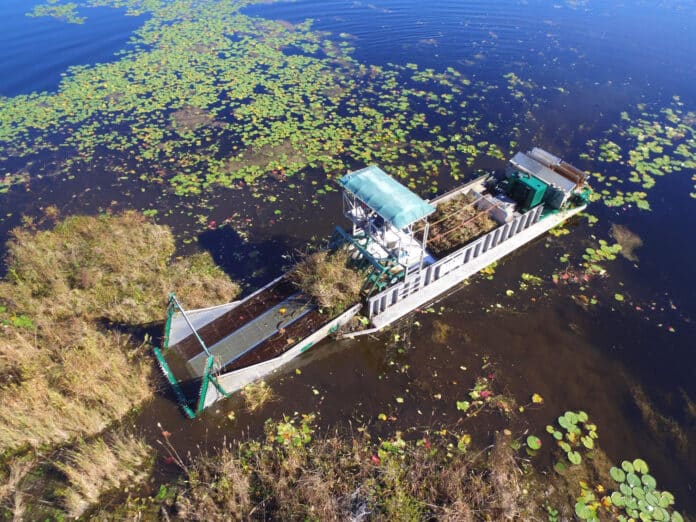At the June 26, 2018 meeting, Aquatic Services Manager Keith Kolasa presented a progress report to the BOCC on the year-long tussock removal project at Hunters Lake and the essential role that Pasco Hernando State College (PHSC) played. The tussocks are an invasive species, reducing the oxygen supply to the fish in some areas and creating hazards for boaters.
In addition to the 1.5 acres of tussocks removed by Florida’s Fish and Wildlife Commission (FWC), the County successfully removed 14 acres of tussocks from the lake. FWC originally planned to remove as much as five acres, but funding issues prevented that.
Kolasa stated that having access to the northwestern section of the lake via the PHSC property had several benefits: deep water access for the harvesters even when the level of the lake dropped, cost reduction with direct access, and elimination of noise/traffic to local neighborhoods. PHSC also provided additional security.
Kolasa stated the driveway and ground needed some improvements before they could begin harvesting. The three 100-foot long harvesters were placed in the water using a crane, so the Department of Public Works (DPW) stabilized a section of ground that would handle the weight of the heavy equipment. Each harvester could carry up to 30 cubic yards of tussocks per trip. A video gave perspective of the size of the harvester compared to the area of tussocks to be removed.
Once the harvester was full, the tussocks were offloaded by DPW and placed in piles to dry, making them lighter and easier to transport. Kolasa showed pictures of the process and estimated that 3,000 cubic yards of tussocks were removed from the lake. Once dry, the tussocks were transported off site and are currently being turned into nitrogen-rich compost. DPW repaired the PHSC property at the end of the project by filling in ruts, smoothing the ground, and planting grass.
Before and after photos show a dramatic improvement in the appearance of the lake and in the accessibility for residents. BOCC Chairman Steve Champion asked about natural ways to limit tussock growth. Boat traffic on the lake could help in the maintenance, Kolasa said. Frequent use of the lake prevents the tussocks from forming large clumps. The boat ramp is open and accessible to the public.
The project was budgeted for $150,000 with the money coming from grants and ESL funds. Kolasa remarked that the project’s actual cost was $121,010. Texas Aquatics, the company contracted to harvest the tussocks, was paid $68,250. The remainder went to DPW for the various tasks they had to prepare the site, work with Texas Aquatics, and to return the land to PHSC in good condition.
The agreement with PHSC for use of the property was for a single use, but the success of the project and the cooperation between the college and the County led Kolasa to propose a five-year land use agreement between the County and PHSC. The improvements the County made to the site benefit the college as well. PHSC’s Board of Trustees and the County’s attorney reviewed and approved the new agreement.
Commissioner Wayne Dukes recommended a resolution that the BOCC could present to PHSC to thank them for their cooperation. “We couldn’t have done what we did without their help,” he said.
The BOCC voted unanimously to approve the five-year land use agreement, and Dukes was given consensus to draft a resolution honoring PHSC.

